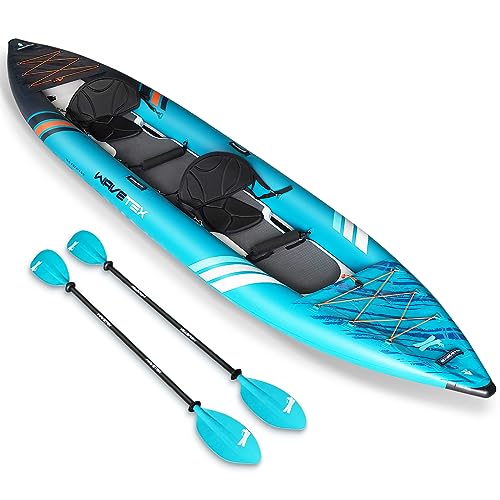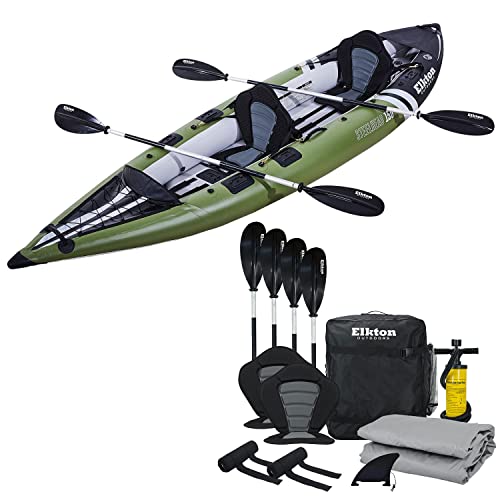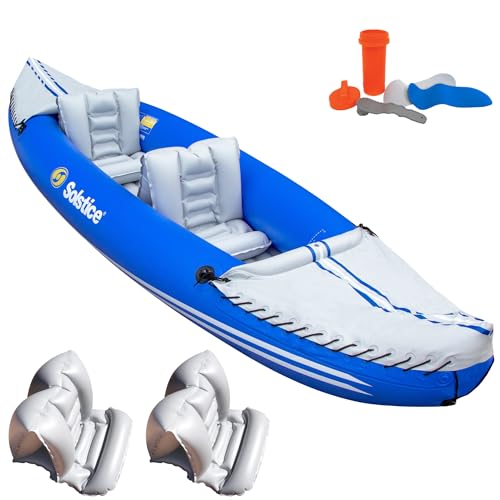2-person blow-up kayaks, an excellent option for shared aquatic adventures, combine the convenience of portability with the thrill of kayaking. These inflatable kayaks are designed to accommodate two paddlers, offering a versatile and enjoyable experience on the water. Key points include their compact size when deflated, making them easy to transport and store, even in smaller vehicles. Many models feature durable materials with reinforced seams for added strength and stability. 2-person blow-up kayaks are ideal for calm lakes, slow-moving rivers, and coastal waters, providing a comfortable and stable platform for tandem paddling. While not as rigid as hardshell kayaks, they offer a great balance between performance, convenience, and affordability, making them a popular choice for casual kayakers and families looking to explore the water together.
Eco-friendly materials used for blow up kayaks
There are eco-friendly materials used for blow up kayaks. TPU or Thermoplastic Polyurethane is an advanced material that is much more environmentally friendly than PVC and other synthetic fabrics. Nitrylon is another material that is more eco-friendly than PVC and Hypalon. However, it is important to note that choosing the best material for inflatable kayaks is a matter of balancing strength, weight, cost, and environmental sustainability.
Blow Up kayaks Features
Inflatable kayaks have become increasingly popular due to their convenience and versatility. Here are some features to look out for in 2-person inflatable kayaks:
- Space: Look for a kayak that has enough space for two people and their gear. Some kayaks have adjustable seats that can be moved to accommodate different body types.
- Rigidity: Some inflatable kayaks have a construction that is similar to a hardshell kayak, which provides better rigidity and performance on the water.
- Attachment points for gear: Look for kayaks with enough storage space for your gear, as well as features like bungee cords or D-rings for attaching additional gear.
- Material: Inflatable kayaks are made from a variety of materials, including PVC tarpaulin, vinyl, fabric materials like nylon, Hypalon, and Nitrylon. TPU and Nitrylon are more eco-friendly alternatives to PVC and Hypalon.
- Safety: Some inflatable kayaks have multiple air chambers for safety and buoyancy if one is punctured.
- Comfort: Some kayaks come with inflatable seats or backrests for added comfort during long paddles.
It is important to consider the intended use of the kayak when choosing the best features for your needs. For example, if you plan to use the kayak for whitewater runs, look for a durable kayak with good maneuverability and attachment points for gear. If you plan to use the kayak for multi-day trips, look for a kayak with comfortable seats and enough storage space for your gear.
Pros and cons of using a tandem blow up kayak
Pros:
- Portability: Inflatable kayaks are lightweight and easy to pack away in their own storage bags, making them convenient for travel and storage.
- Buoyancy: Inflatable kayaks float more and parts of them don’t submerge right away, which can be an advantage in rough waters.
- Durability: Modern inflatable kayaks are made of durable materials that can withstand punctures and abrasions.
- Affordability: Inflatable kayaks are often less expensive than hard-shell kayaks.
- Easy to store: They can be deflated and packed into their storage bag, making them easy to store in small spaces.
Cons:
- Performance: Inflatable kayaks are typically slower and less efficient in rough waters compared to hard-shell kayaks.
- Puncture risk: Inflatable kayaks can be punctured by rocks or sticks in shallow waters, and leaks can turn worse.
- Durability: Some inflatable kayaks have durability issues, especially single and tandem kayaks.
- Harder to paddle: Inflatable kayaks can be harder to paddle, especially in windy conditions or against natural forces.
- Limited storage space: Inflatable kayaks may have limited storage space for gear compared to hard-shell kayaks.
It is important to consider the intended use of the kayak and personal preferences when deciding whether an inflatable kayak is the right choice. While they have some limitations, inflatable kayaks can be a great option for those looking for a portable, affordable, and easy-to-store kayak that can provide a fun and enjoyable paddling experience.
Safety concerns with using a blow-up kayak
Inflatable kayaks can be a safe and enjoyable way to explore the water, but there are some safety concerns to keep in mind:
- Tipping: Inflatable kayaks can be more susceptible to tipping than hard-shell kayaks, especially in rough waters.
- Currents and winds: Inflatable kayaks can be more easily affected by strong currents, waves, and winds, which can make them harder to control.
- Puncture risk: Inflatable kayaks can be punctured by rocks or sticks in shallow waters, which can cause leaks and make the kayak less stable.
- Limited buoyancy: Inflatable kayaks may have less buoyancy than hard-shell kayaks, which can make them less stable in rough waters.
- Safety equipment: It is important to have the proper safety equipment, such as life jackets and paddles, and to know how to use them properly.
To ensure a safe and enjoyable paddling experience, it is important to take proper precautions and follow safety guidelines, just like with any other type of boat. This includes wearing a life jacket, checking the weather and water conditions before heading out, and avoiding areas with strong currents or rough waters if you are a beginner.
Water conditions that are unsafe for inflatable kayaks
In general, inflatable kayaks are safe to use in a variety of water conditions. However, there are certain water conditions that may pose more risks and require extra caution when using an inflatable kayak. Here are some specific water conditions that may be unsafe for inflatable kayaks:
- Harsh conditions or rough water: Inflatable kayaks are not built for extreme conditions or rough waters, such as whitewater rapids or strong ocean currents. Using an inflatable kayak in these conditions can increase the risk of tipping or damage to the kayak.
- Rivers with rapids and debris: Paddling on a river with rapids and debris can be hazardous for inflatable kayaks. The fast-moving water and potential obstacles can pose a greater risk of punctures or damage to the kayak.
- Strong winds and currents: Inflatable kayaks can be more easily affected by strong winds and currents, which can make them harder to control and navigate. It is important to be aware of the weather conditions and water currents before heading out on the water.
While inflatable kayaks are generally safe, it is important to use common sense and exercise caution when choosing the appropriate water conditions for your inflatable kayak. Always prioritize your safety and be aware of the limitations of your kayak in different water conditions.
Thesandshore.com is a source where the post Tandem 2-Person Blow Up Kayaks appeared first.










